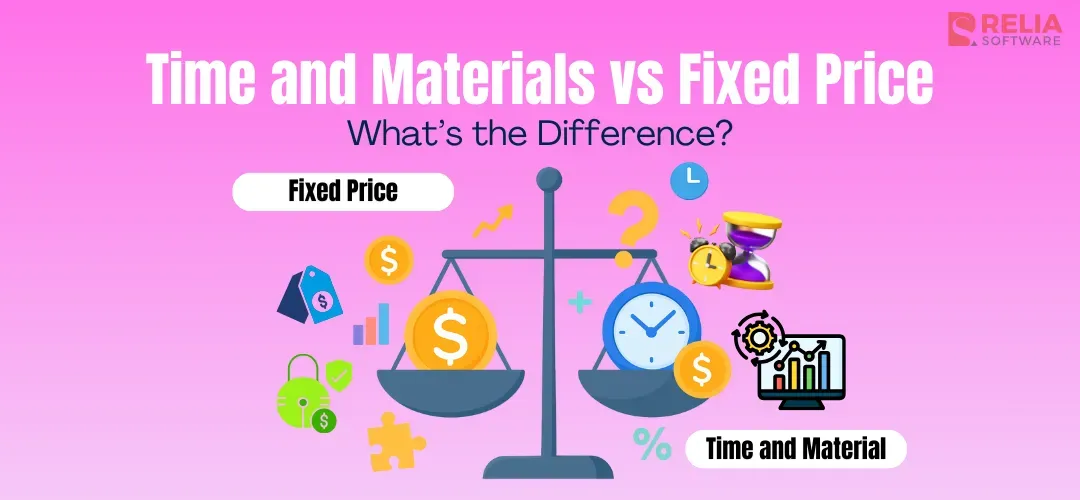In software development, Time and Materials (T&M) and Fixed Price models are two popular pricing models in software development that operate in completely different ways. One can adjust as the work changes and grows, while the other stays fixed and follows a defined plan. Understanding their differences helps you decide which one gives you the level of control, stability, and flexibility you need.
This article will give you a comparison of Time and Materials (T&M) vs Fixed Price models. By the end of this blog, you will have a clear view of how both models work in real projects, how they differ in working scope, requirements, and payment so that you can choose the one that matches your goals.
Overview of T&M And Fixed Price Model
Time and Material (T&M) is a pricing model that bills you for the actual hours the team works and the materials needed during the project. The cost changes based on the amount of work involved, which makes this approach useful when the project scope is open or still taking shape. You can adjust priorities, add new ideas, or shift the direction of the project without waiting for a new estimate or contract update.
Oppositely, Fixed Price sets the cost, scope, and timeline before any work begins. The team follows a defined scope with clear deliverables, and the price stays the same, meaning there is little room for change. This works well when you already know what you want to build and expect the project to move through a steady plan from start to finish, with little need for adjustments.

Time and Material (T&M) vs. Fixed Price Model: Key Differences
Let’s have an overview of key differences between T&M and Fixed Price models in the table comparison below before going into a detailed explanation.
Acpects | T&M | Fixed Price |
Project Requirements | Unclear or may change during development time | Clear and well-defined from the start |
Scope of work | Open, evolving, or needs experiments | Fixed with no expected changes |
Client Involvement | Higher | Lower |
Budget Approach | Based on actual work and hours | Set upfront and mostly stays stable |
Flexibility | Very flexible for unclear or evolving ideas | Less flexible; best for fixed requirements |
Timeline | Adapt as you go | Tight and must follow a set plan |
Risk | Cost risk | Delivery or quality risk |
Budget Certainty | Harder to predict the total cost | Know the total cost from the start |
Project Requirements
T&M works well when the project requirements are still forming or may change as the work moves forward. It gives you time to explore ideas, react to early feedback, and shape the final outcome at a comfortable pace. When new insights appear, the team can shift tasks or adjust priorities without slowing the project down.
In contrast, a Fixed Price model requires clear and stable requirements from the beginning. The work begins with detailed scope documents that outline what will be delivered, how it will function, and how long it should take. Since everything is defined upfront, the team can move from start to finish without interruption of making many changes along the way.
Scope of Work
Under a T&M model, the working scope can stay open and adjust as the project moves forward. New features can be added, removed, or reshaped whenever feedback or testing shows a better direction. Some ideas may grow into larger tasks, while others may shrink or be replaced as business needs change. This makes it easy to react to real progress instead of trying to predict everything early on.
By contrast, a Fixed Price model keeps the scope firmly set from the start. Any changes must go through a formal approval process or a change request before being conducted, affecting the project timeline. Agreeing on these details before development begins is important, as it ensures both sides understand exactly what will be built and how it will be measured at the end.
Cost Comparison
The cost of Time and Material contract is based on the hours the team works and the amount of effort each task requires. If the scope grows, the cost grows with it. Some teams keep things under control by setting a budget cap or planning spending in small milestones so they can track how the work moves forward.
T&M cost formula: Total Cost = Hourly Rate × Hours Worked + Cost of Materials (if any)
Meanwhile, in the Fixed Price model, the full project cost is agreed before any work begins, based on a clearly defined scope. If the scope needs to change later, the cost will be defined through a new estimate or change request. Vendors sometimes also add a buffer in the fixed price to cover extra effort that might appear.
Project Control
T&M model lets the client have the main control during the project. They can change priorities, update tasks, or test different ideas as the product grows. The development team needs to check in, and the client’s direction guides the work regularly. This setup fits projects that need ongoing input and allows the timeline to remain flexible, since new work can extend the schedule as the project evolves.
In a Fixed Price model, the client is mainly involved at the start and at a few key review points, not every day like in T&M. Once the scope, timeline, and deliverables are approved, the development team mainly controls the process. They follow the agreed plan and keep the project on track without changing the direction. Any change requires a new agreement to avoid affecting the schedule or overall cost.
>>You may be interested in: How To Manage A Software Development Team?
Disadvantages Considerations
In a T&M contract, the client mainly carries uncertain cost challenges, since the final amount can rise when new features or extra work are added. Another risk is longer timelines, as more tasks naturally extend the schedule. Clients usually avoid these risks by setting budget caps, checking weekly reports, and reviewing priorities often so the software team focuses on what truly matters.
By contrast, the Fixed Price model places most of the disadvantages on the software team. They must finish all agreed work within the fixed amount, even if some parts take more time or effort than expected. When this happens, the team may limit changes to stay on budget. This keeps the client’s cost stable but reduces flexibility and can result in non-optimized solutions.
When To Choose T&M vs. Fixed Price Model?
Each model fits different types of projects, so matching the right approach to the right situation makes planning much easier. The table below outlines the specific use cases for each model.
When To Use T&M? | When To Use Fixed Price? |
Tech startups building new MVPs | Any small businesses’ websites with clear layouts |
Fintech platforms need frequent regulatory updates | Education portals with structured LMS features |
MedTech apps requiring iterative testing | Manufacturing dashboards with fixed functions |
AI or ML projects involving experiments and model training | Real estate listing websites with predictable features |
E-commerce platforms doing continuous UX fixes and A/B tests | Local business (e.g., SMEs) corporate websites |
SaaS apps release new features monthly | Government projects with fixed tender requirements |
Logistics systems integrating multiple APIs | Marketing agencies creating landing pages or promo apps |
Long-term maintenance or ongoing enhancement work | Build small mobile apps with a defined set of screens and tasks |
FAQs
1. Can I switch from Fixed Price to T&M later?
Yes. Many teams switch when the project starts changing more than expected. In this case, the fixed-scope part is completed as planned, and the remaining work continues under T&M so new tasks, ideas, and fixes can be handled without constant contract updates.
2. How do I control costs in a T&M model?
The most common way is to set a monthly or sprint-based budget limit. You can also review time logs, check progress weekly, and focus the team only on the tasks that matter most. These steps keep spending visible and prevent the project from expanding without control.
>> You may be interested in: How To Reduce Software Development Costs?
3. Is Fixed Price always cheaper?
Not always. For the same amount of work, a Fixed Price contract is often not cheaper, because vendors usually add a risk buffer for unknowns and future changes.
Time and Materials can actually cost less if the scope is clear, the team is efficient, and the project is well managed. Fixed Price mainly gives you stable payments and easier budget control, not the lowest cost.
4. Which model works better for long-term work?
T&M usually suits long-term projects better because priorities change often. The team can adjust tasks, add improvements, and refine the product over time without renegotiating the entire contract. Fixed Price works better for short, predictable tasks that have a clear ending point.
Conclusion
The difference of Time and Material vs Fixed Price models is mainly in how each one handles scope, cost, and the level of flexibility you need. T&M charges for the actual hours and materials used, offering flexibility and control for projects with evolving requirements, while a fixed-price contract sets a single, upfront cost for a well-defined project with a fixed scope.
Choosing the right model that matches how your project operates makes planning clearer and helps the team deliver with fewer surprises. Remember to define clearly your project requirements as well as business needs and budget abilities before making a decision.
>>> Follow and Contact Relia Software for more information!
- development
- outsourcing

